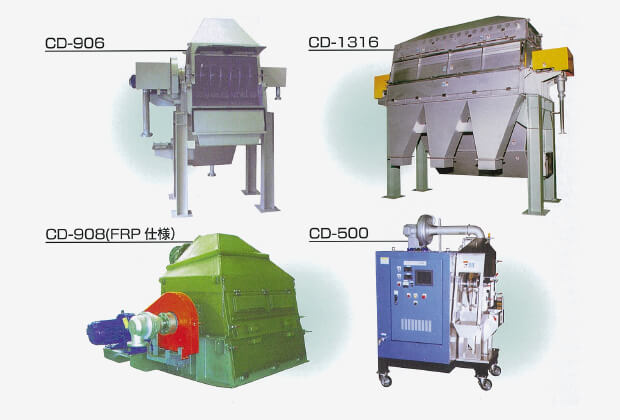- HOME
- Case Studies
CD Dryer
Improving Productivity ・ Protecting the Environment
Manufacturers and researchers tell us, "We want to efficiently produce powder from our product slurry." and "We want to recover and recycle resources from our waste liquid." The CD Dryer can help attain these goals. We increased the heat transfer efficiency to provide an unprecedented high-performance dryer that uses steam as its heat source.

Result of Application
Recovery of Resources
Company A was spending 90,000,000 yen/year on disposal of waste liquid from their rare metal recovery process. Using the CD Dryer, Company A has greatly reduced waste liquid treatment costs. In addition, they gained a new source of earnings by selling metals collected from the waste liquid.
- Before
- In the process of recovering rare metals from metal waste, 10 tons of copper nitrate-containing waste liquid were generated per day. The water content could only be reduced from 84% to 60% by pressing. The copper nitrate was disposed of as industrial waste.
- After
- The introduction of CD Dryers reduced combined running and disposal costs by 60,000,000 yen.
Company A now reduces the water content of their waste liquid to 20% and is able to sell all of the recovered copper nitrate. This has led to an increase in earnings of ¥5 million per year.
Thanks to this application, the plant has also achieved its goal of zero emissions.
Cutting the High Cost of Wastewater Treatment
"Waste liquid collection costs are high," "We're unable to treat wastewater from our new product development," or "How can we safely dispose of liquids containing hazardous materials?" These are some problems which can be solved using a CD Dryer. While outsourcing the wastewater disposal to an outside contractor is one solution, with the introduction of a CD Dryer, it is possible to reduce waste disposal costs through in-house treatment, as in the case of Company B.
- Before
- After concentrating 6000 tons per year of plating waste liquid to 1200 tons, the remainder was outsourced for industrial waste treatment. The combined cost was 36 million yen per year.
- After
- Using a CD Dryer to dry the liquid, the volume of industrial waste was reduced to only 25 tons per year. Industrial waste disposal costs were cut to 760,000 yen per year.
A-VCD Dryer
- Before
- Customer C was looking for a way to treat cleaning solution containing organic solvents.
- After
- Solid-liquid separation is carried out in a vacuum-type A-VCD Dryer, and the volatile solvents are recovered and reusable. The solid content is dried, and a reduction in industrial waste costs has been achieved.
The reuse of recovered solvents has reduced in-house costs for cleaning solution as well as reducing the burden on the environment, pleasing the customer on both fronts.
Conveyor Applications
I-B Conveyor
- Before
- Customer D was using an outer bucket chain conveyor to transport foundry sand.
Buckets were often damaged or deformed by scraping up and conveying sand from the base of the machine. Buckets frequently fell off the chain, causing the conveyor to stop. Frequent maintenance was also necessary.
- After
- After introduction of an IB Conveyor, the frequency and cost of maintenance were drastically reduced. Unlike outer bucket chain conveyors, the Nishimura I-B Conveyor requires less power to operate and receives less wear to the buckets. The customer no longer experiences bucket fall-off. Since the I-B Conveyor is part of an important line in which operations themselves stop when the conveyor stops, the improvement is highly appreciated.
Over 900 I-B Conveyor units installed!
| Applications | ||
|---|---|---|
| Granulated slag | Coke | Coal |
| Lime | Iron powder | Glass |
| Ferroalloy | Wooden pellets | Refractory materials |
| Ceramics | Silica stone and sand | Gypsum |
NZ Conveyor
- Before
- Customer E was looking for a way to transport powder to the upper floor of its fertilizer plant.
- After
- The company installed two NZ Conveyor units. They have been in operation for almost 30 years with little maintenance. Thanks to the collection buckets with scrapers, the customer is very satisfied that clean-up of powder spilled in the conveyor is not necessary.
